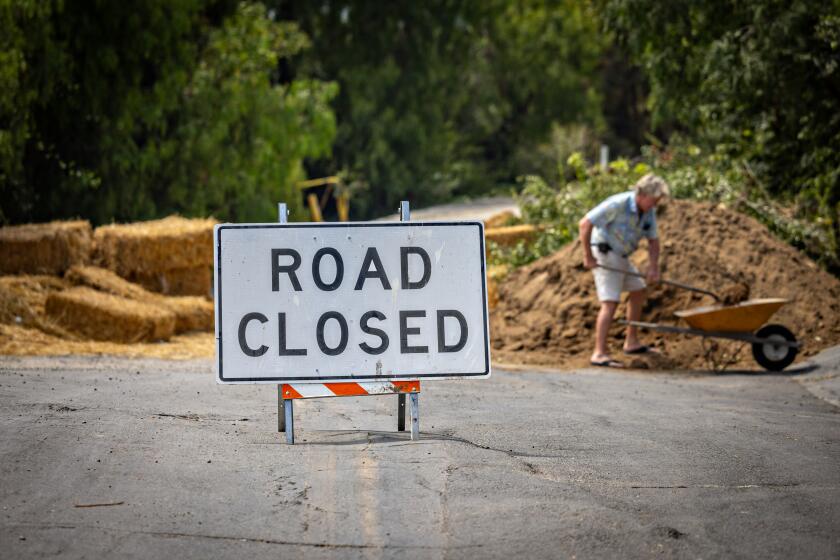Home prices climb 12.1% in June, index shows
Home prices posted double-digit gains for the fourth consecutive month in June, raising concerns among some analysts that speculative forces are driving the market.
Home prices rose 2.2% from May and 12.1% over June 2012, with Western cities leading the increases, according to the Standard & Poor’s/Case-Shiller index for the nation’s largest 20 cities. Every city tracked posted an increase on the nation’s leading home price index. Only six cities saw prices rising faster in June than May, indicating that the torrid pace of gains may be easing.
Nevertheless, more than half the cities tracked by the index posted double-digit gains compared with the same month last year. Western cities saw the biggest increases, with Las Vegas up 24.9%; San Francisco, 24.5%; Los Angeles, 19.9%; Phoenix, 19.8%; and San Diego, 19.3%.
The big gains in the Los Angeles metro area, with its long history of booms and busts, should raise concerns, said Robert J. Shiller, a Yale economist and co-creator of the index.
“That is one of the cities I would be more concerned about because it has a history of speculative volatility,” Shiller said.
Whether a bubble will form again in Los Angeles is hard to say. Housing is driven by psychology, culture and the stories we tell one another about real estate, Shiller said. Although other Western areas, such as Phoenix and Las Vegas, are also rising rapidly, they do not have the same boom-and-bust history as the Southland.
The Case-Shiller data tend to lag behind other housing indicators, which lately have indicated the market may be cooling. The National Assn. of Realtors recently reported that the national median home price was $213,500 last month. That was a slight slip from the $214,200 median in June but up 13.7% from July 2012.
The real estate group also reported that housing inventory rose 5.6% last month to 2.28 million homes available for sale, representing about a five-month supply at the current sales pace. Economists typically consider six months’ worth of supply to be a balanced market.
The June Case-Shiller numbers were expected to be strong given that the month is one of the year’s peak home-buying periods, said David M. Blitzer, chairman of the index committee at S&P. Home price increases in coming months should be tempered, particularly with mortgage interest rates rising, he said.
“The Southwest and California have consistently led the recovery,” Blitzer said. “Overall, the report shows that housing prices are rising, but the pace may be slowing.”
The housing recovery began last year as foreclosures plunged and buyers chased bargains on homes and mortgages. Investors of all stripes — from small syndicates of wealthy individuals to large Wall Street players — have played a huge role in the housing recovery, snapping up many of the cheapest homes to flip or to rent out.
Many experts believe home prices can’t continue to shoot up at the current pace for long without jobs and wages seeing strong increases. Rising interest rates and relatively tight access to mortgage credit could put runaway prices in check.
“When interest rates start rising, and housing prices start rising, we will get to the point where both have risen enough so they are no longer attractive,” said Anthony Sanders, a professor of real estate finance at George Mason University in Virginia. “We are probably going to see the market cool down quite a bit.”
Home prices have risen rapidly this year nationwide and exploded in coastal markets.
Standard & Poor’s also released the Case-Shiller U.S. national home price index, which is issued quarterly and covers the whole nation rather than just major cities. That national index showed a 10.1% gain in the second quarter over the same period last year.
Overall, home prices remain a good distance from their 2006 peaks. The 20-city index is now about 23% below its July 2006 high point. San Francisco, which has gained the most of the big metro areas, is 21% off its peak. Phoenix, the second-biggest gainer, remains 40% off its peak. And the Los Angeles metro area, which includes Los Angles and Orange counties, is 26% off its peak.
Topping those old home price highs would not necessarily be a sign of a healthy market. During the boom years, affordability plummeted in California, with only 12% of the home-buying population able to buy a home at the median price during most of 2006. A torrent of irresponsible lending drove the gains in home prices then, with many of the most careless mortgages being written that year.
Qualifying for a mortgage these days has become much tougher. Affordability peaked last year in California, but rising home prices and interest rates have pushed affordability back closer toward historical averages.
Nationally, all 20 cities tracked by the Case-Shiller index posted positive gains for the third consecutive month. The price gains accelerated in six of the cities tracked: Charlotte, N.C.; Cleveland; Las Vegas; Minneapolis; New York and Tampa, Fla.
Erik Johnson, an economist with IHS Global Insight, predicts prices will continue to rise in the near-term despite the increase in mortgage interest rates.
“Home prices have continued to rise across the country because of inventory shortages,” Johnson wrote in an emailed analysis. “Since underlying demand is, by our estimate, running at a rate nearly twice that of housing completions, the shortages are likely to get larger before getting smaller.”
More to Read
Sign up for Essential California
The most important California stories and recommendations in your inbox every morning.
You may occasionally receive promotional content from the Los Angeles Times.






